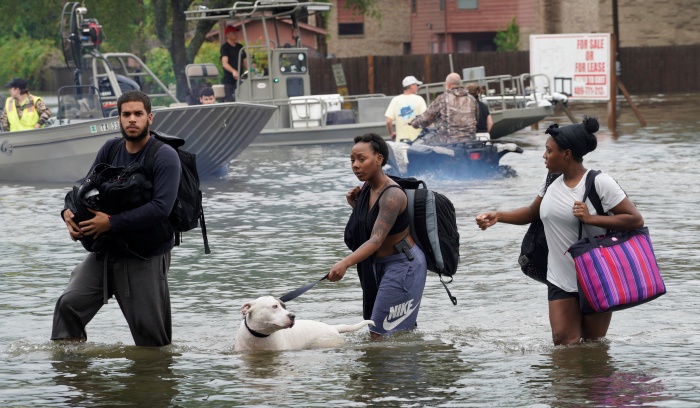CDP North America’s Bruno Sarda says global warming poses a material and physical risk for mayors. But for true resilience climate action must go hand in hand with tackling social equity
When Oxford Dictionaries named “climate emergency” its 2019 word of the year, I was struck by the implications. Months prior, The Guardian announced it would begin using “climate emergency” exclusively in its reporting, ditching the less resonant “climate change”.
More than 1,400 local governments in 26 countries have declared a climate emergency and committed to action to drive down emissions at warp speed. The message is loud and clear: we must no longer think of environmental threats as approaching dangers: they are here now, already wreaking havoc on America’s cities.
At CDP, a global environmental disclosure nonprofit where I lead our work in North America, our conversations have moved well beyond rising sea levels; climate change is a multi-layered danger that hurts cities across the US, be they inland, coastal, dry, rainy, north or south. In 2019 alone, we saw fires tear through southern California, the Mississippi river flood at historic levels and record-breaking heatwaves and cold spells endanger life across the Midwest.
Unlike companies, cities cannot pick up and move to safer ground
American cities must act now to protect their citizens and economies in the face of the climate crisis. But how?
Unlike companies, cities cannot pick up and move to safer ground. And if a city’s citizens and businesses did relocate due to environmental risk, what would that mean for the city? After all, in 2017, 18 million people around the globe were displaced by climate change, many of whom continue to face almost insurmountable difficulty.
It is an existential question for urban leaders, and local economies are in jeopardy for this very reason, even beyond the ongoing and expensive impacts of environmental disasters when they strike. Cities today face the question: do they retreat from action? Re-invest their spending? Or wait out the (sometimes literal) storm and see what calamities come their way?

Alongside recent climate emergencies, some of 2019’s most critical environmental moments emerged out of cities: the rise of Extinction Rebellion in London and massive mobilisation by young people at urban climate strikes around the world; the Chilean president forced to cancel plans to host the UN annual climate conference after severe economic inequality sparked protests in host city Santiago; preliminary momentum building toward the US 2020 election and the rise of the Green New Deal. These moments do not exist in a vacuum. They are proof that cities are feeling the impacts of climate change already, and their citizens are pushing back.
Wall Street is taking note of how cities are managing climate risk. Climate change poses a material risk to city bond issuances and rating agencies’ assessments. In 50 or 100 years, if city hall is under water or there are no substantial taxpayers left, how could a city pay back what it has borrowed?
In 2017, Moody’s S&P Global and Fitch Ratings issued reports warning state and local governments that their exposure to climate risk could affect their credit ratings. And municipal credit analysts and ESG fixed-income managers in firms like Invesco and AllianceBernstein are taking stock of how cities are transparently reporting these risks to factor into their credit analysis.
When it comes to action, cities are on the forefront, leading when the current federal government is not
City planners are taking note. CDP saw more than a 20% increase in disclosure from local governments between 2018 and 2019, from 750 to 920 global cities, states and regions. This transparency is crucial for understanding risk and acting on it.
When it comes to action, cities are on the forefront, leading when the current federal government is not. There are many examples of leadership here in the United States. American cities are well represented on CDP’s A-List, from West Palm Beach to Seattle. The score is based on how cities are effectively managing, measuring and tackling greenhouse gas emissions and adapting to climate risks. Still, just 7% of cities – 43 worldwide, including 24 in North America – received an A for climate leadership and action.
Cities need to increase transparency through robust environmental disclosure and build their physical resiliency while simultaneously reducing their footprints. For example, New York City, a CDP A-List city, utilised the findings from its post-Hurricane Sandy Resilient Neighborhoods Study to safeguard waterfront buildings and better protect more than 250 hectares of tidal and freshwater wetlands in Queens and Staten Island, a natural flood barrier protecting communities that lie on the Atlantic coast.

Resiliency must go hand in hand with equity. As city leaders tackle climate change, they are accountable to do so in a socially equitable way. Environmental injustices have a disproportionate impact on communities of colour and low-income communities in the United States and around the world.
Cities report to CDP the social risks they believe will stem from climate change. Top long-term concerns are population displacement and the spread of disease. But cities tell CDP that wealth inequality is a significant barrier to combatting climate change: 54 cities in 2019 to be precise, according to our new Cities at Risk report.
But solutions do exist. CDP’s Matchmaker is a platform for cities to build resiliency by seeking investment in their climate infrastructure goals, while ensuring those projects are developed with social equity in mind. Out of the $96.9bn in project value disclosed by cities to CDP in 2019, $25bn has not been secured. Increased funding for city climate initiatives will be required to drive down emissions and adapt to climate risks.
By 2050, 70% of the world’s population will live in cities and eight times as many city dwellers will be exposed to high temperatures
Finally, collaboration is key. Cities can only do so much on their own. They can’t reach these environmental goals without the support and insight of nearby business, as some cities control only 4% of their carbon emissions. More than 60% of cities disclosing to CDP in 2019 are already engaged in city-business collaboration, and we are seeing continued demand for partnerships. Cities are joining forces to find solutions on a local as well as a national scale; the mayors of the Mississippi River Cities and Towns Initiative address shared climate challenges like flooding and extreme heat regionally, and the US Climate Mayors is a bi-partisan peer-to-peer network of mayors working together to demonstrate leadership on a national scale.
By 2050, 70% of the world’s population will live in cities. By this time, eight times as many city dwellers will be exposed to high temperatures and 800 million more people could be at risk from the impacts. With the clock ticking toward 2030, the year by which the IPCC tells us we must halve emissions globally in order to limit warming to a 1.5C rise, cities must act now.

Bruno Sarda is president of CDP North America
This article is part of our in-depth Decade of Delivery commentary from sustainability leaders. To view all articles, please see our January 2020 digital magazine.
#deliverydecade climate emergency C40 Cities California wildfires Green New Deal Cities at Risk CDP Matchmaker IPCC


